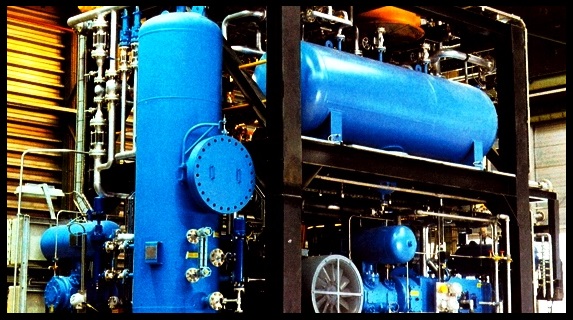Compressor Overpressure Incident
What happened?
Following routine maintenance at a processing facility, the first and second stages of a compressor were severely over-pressurised during de-isolation. In the ensuing efforts to rectify the situation, operations personnel were exposed to a risk of a catastrophic failure of equipment and being enveloped by a gas cloud.

What went wrong?
During maintenance work the compressor was isolated from a common gas export header via a double block and bleed arrangement. The bleed line had been used to depressurise the compressor prior to the high pressure flare header being isolated.
Following maintenance, the de-isolation process was commenced by opening the valve to the gas export header without realising the bleed valve was still open. As a result, the pressure increased along the pipework downstream of the pressure safety valve up to the isolating valve on the flare header.
At the same time, gas flowed through the blow-down and recycle valves to the first, second and third inlet sections of the compressor, which were open following de-energisation of the system. This was partly due to pipework modifications made in the 1990’s which allowed high pressure gas to back-flow into the low pressure first stage suction side of the compressor.
The valve isolating the high pressure flare header was then opened slightly and an unexpected gas flow was noticed that started to ice up this valve. During the process of investigating the unexpected process conditions, a request to undertake another task was received.
Before leaving the compressor area to undertake this new task, the valve flare header valve was closed, allowing the pressure to continue building up at the compressor inlet. Before the de-isolation process could be resumed, a flange and a seal on the compressor burst resulting in a gas leak, and triggering a gas alarm and plant trip.
Due to concern about the icing up of the flare header valve, three operators proceeded to the compressor and vented the pressure through scrubber vents. The first stage scrubber was pressurised to almost four times its normal operating pressure so that a catastrophic failure of equipment and associated rapid release of a gas cloud could have resulted.
Factors which contributed to the incident included:
• The work was considered routine and although isolation points were listed on an isolation certificate, there was no sequencing for valve opening and closure and no independently verified procedures for the isolation and de-isolation process.
• Isolation of the flare header from pressure safety valves was an accepted practice for this type of work.
• Operations had not been planned to take for account of all activities and available personnel.
• The specific role of each valve was not well understood.
• There was a modification to the compressor manifold skid piping, undertaken in the 1990’s which increased the risk of this event by creating the capability of interconnecting low pressure and high pressure flare headers.
• There were no pressure alarms on the interstage vessels, which may have alerted personnel to the overpressure danger.
• Recovery of the situation was not conducted from a position of safety.
Key lessons:
• Operations should be planned to ensure that adequate resources are made available to undertake the work safely.
• Standard procedures for conducting isolation and de-isolation activities should be in place and independently verified, and personnel should be trained and competent in their use.
• Work which involves isolation of equipment from relief systems should be avoided where possible, except where pressure in the system has been reduced to, and maintained at, sufficiently low levels to minimise the risk.
• Training should be conducted to ensure that personnel can recognise the hazards from overpressurisation and gas releases, and to ensure that in the event of an incident, the coordination of recovery activities is conducted from a position of safety.
• Any changes to plant, such as the interconnection between the high pressure and low pressure flare headers, should be properly reviewed under the Management of Change system.